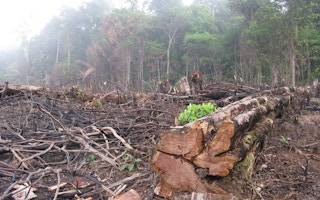The world’s tropical forests are a key part of slowing climate change, and ensuring indigenous peoples have land rights is essential to protecting them, US-based researchers say.
A campaign group, Global Witness, puts the number of land and environment activists killed since the end of 2009 at around 650. It says most died fighting to protect remote land from development which had been approved by governments.
Speaking in New York as world leaders gathered there to sign the Paris Agreement on climate change, the administrator of the UN Development Programme, Helen Clark, said: “If we want to protect the world’s forests, we must safeguard the rights of the indigenous peoples and forest communities who have sustainably managed their forests for generations.
“Clarifying local land rights and tenure security will be a crucial determinant of success for the new global frameworks on climate change and sustainable development.”
She was speaking at an event organised jointly by the UNDP and the Ford Foundation to mark the signing of the Agreement.
Balancing emissions
Another speaker, Frances Seymour, of the Center for Global Development (CGD), said protecting the tropical forests of South America, Asia and Africa was one of the most cost-effective climate solutions available today: “Stopping deforestation and allowing damaged forests to grow back could mitigate up to 30 per cent of current global emissions.”
A new analysis by the Woods Hole Research Center (WHRC) spells out what the forests do for the climate. If the world fails to protect them, it says, it will have to eliminate all greenhouse gas emissions from fossil fuel use by 2035 in order to limit warming to 2ºC, the goal identified as vital for avoiding the worst impacts of climate change (though the Paris Agreement is aiming for a 1.5°C limit).
Properly managed, the analysis says, the forests could provide 10-15 more years to end fossil fuel use while keeping global warming under 2°C. It uses the 2015 Global Forest Resources Assessment produced by the UN’s Food and Agriculture Organization in reaching its conclusions.
“It is clear that it will be impossible to limit global warming to 2ºC at this point if we try to do it entirely by reducing fossil fuel use,” said Dr. Phillip Duffy, WHRC’s executive director.
The Woods Hole analysis suggests that to keep global warming under 2°C, while retaining the current level of land-based carbon emissions, fossil fuel use would have to be eliminated by 2035. But stopping tropical deforestation and expanding forest area by 500 million hectares could extend the deadline for reaching zero carbon emissions to 2049.
“
Money disappears, but forests do not. The forests will be here for this generation; for our children’s generation and for all the generations to come. We will make sure of that.
Diana Rios, daughter of slain forest protector and Ashaninka leader
The organisers of the New York event say indigenous environmental leaders are under growing threat for their opposition to projects that threaten their communities and their forests. A Cambodian activist, Phon Sopheak, remains in hospital after being attacked on 26 March by illegal loggers with axes during a patrol of the forest.
Earlier that month a well-known Honduran activist, Berta Cáceres, was murdered. In 2014 Edwin Chota, Jorge Ríos Pérez, and two other Ashaninka leaders in Peru were murdered, all, the organisers say, “emblematic of the violence being perpetrated by industrial interests in the indigenous areas whose preservation is crucial to helping the world to achieve carbon neutrality”.
Diana Rios, of Peru, whose father was one of the four Ashaninka leaders shot, said: “Money disappears, but the forests do not. The forests will be here for this generation; for our children’s generation and for all the generations to come. We will make sure of that.”
Little commitment
The WHRC analysis says there is significant evidence that forest peoples, if given land rights, are the best managers of tropical forests in retaining old growth and storing carbon. For example, it says, community and indigenous forests in Brazil store 36 per cent more carbon per hectare and emit 27 times less CO2 from deforestation than forests not under community control.
Yet very few countries, with just 13 per cent of the world’s tropical and subtropical forest area, are clearly committed to implementing community-based land tenure or natural resource management strategies, says the Rights and Resources Initiative. The world’s largest forest countries, including DRC, Brazil and Indonesia have not committed themselves.
“The Woods Hole findings reinforce our dependence on the tropical forests, which hold a safe, natural, and proven technology to capture and store carbon”, said Frances Seymour of CGD. “It is called photosynthesis, and it needs to be part of the solution.”










